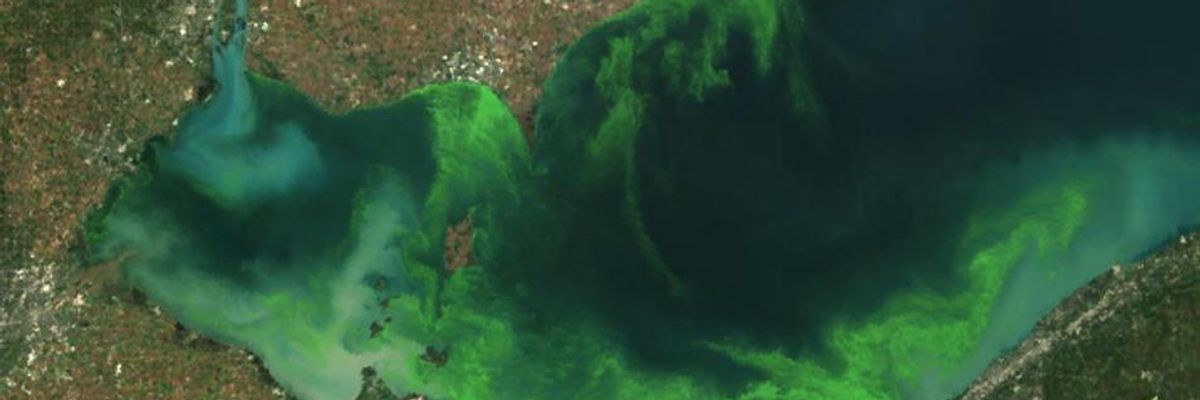The mayor of Toledo, Ohio on Monday morning announced that in conjuncture with the state EPA he was lifting the emergency "do not drink" order that had left nearly half a million city and nearby residents without water over the weekend following the detection of dangerous levels of microcystin, a toxin created by algae blooms that likely stem farm fertilizers used in the region.
"Our water is safe," said Mayor D. Michael Collins at a morning news conference outside the Lucas County Emergency Services Building, calling it a "good day" for area residents.
However, experts note that the algae bloom--which is being fed by the phosphorous-laden agriculture runoff from the region's farms--will continue to be fed and that the hot, dry weather of late summer is likely to exacerbate the conditions in which the microcystin flourishes.
Microcystin can specifically target the liver of those who ingest it and is particularly harmful--and possibly deadly--for older people, those with pre-existing liver damage or immunity problems, and young children. The toxin is also deadly for animal life and the areas overall ecosystem.
In a letter (pdf) sent to the mayor's office approving the lifting of the ban earlier in the day, director of the Ohio EPA Craig Butlter said, "Laboratory analyses of samples collected at the Collins Park Water Treatment Plant and throughout the distribution system indicate that contaminants have been consistently below the drinking water advisory threshold."
Writing for the Toledo Blade, local journalist Tom Henry was among those who toured Lake Erie on Sunday as he took in a firsthand look at the "pea soup color" of the algae bloom that was the source of the crisis:
The lake's rapid deterioration 2 miles off the Toledo shoreline created a gripping sight on Sunday for about 20 people -- a combination of journalists, elected officials, and environmentalists -- aboard a vessel captained by Vern Meinke, owner of Meinke Marina, of Curtice, Ohio.
Many of them compared the lake's current color to that of pea soup. As Mr. Meinke's boat plied the water, waves behind it looked like thick, green paint.
"What we've experienced here shows us this is a dangerous situation," Toledo Councilman Larry Sykes said.
He's not known for being a rabid environmentalist, nor is he known for failing to speak his mind. He seemed utterly dumbfounded how such a beautiful body of water could be transformed into sheer ugliness virtually overnight, fouled by a toxic form of algae known as microcystis that is fed by excessive phosphorus from farm runoff, lawn fertilizers, and sewage overflows.
Writing for the Guardian on Sunday, environmental journalist Suzanne Goldenberg looks at the potential causes of the algae bloom which have intensifed in the Great Lakes in recent years, but especially in Lake Erie. Goldenberg reports:
An Ohio state government task force found that Lake Erie received the most phosphorus of any of the Great Lakes - 44% of the total for all of the lakes. Two-thirds of that phosphorus came from crop land, with an average load of 1.43lbs per acre, the report found.
There is evidence also that a particular kind of fertiliser could be the main driver of the toxic algal blooms. Researchers from Heidelberg University say there has been a rise in dissolved reactive phosphorus, which is soluble in water and is more available to promote algal growth. The researchers found a decline in the other form of the nutrient, particulate phosphorus, over the same time period.
Circle of Blue, in a major research project on Lake Erie algal blooms, also found a potential link to a switch to no-till farming in nearby farms.
Lake Erie has also grown more susceptible to the algal blooms because of invasive species and climate change. Heavy rains in spring and early summer - a critical time for algal bloom formation - cause more phosphorus to enter the lake through agricultural runoff. Hotter temperatures then cause the blooms to spread.
On Monday, in fact, the National Oceanic and Atmospheric Administration (NOAA) released its annual report on the notorious Gulf of Mexico "Dead Zone" which results from the agricultural runoff accumulated in the Mississippi River watershed.
This year's findings showed the dead zone in the Gulf is enormous --calculated at more than 5,000 square miles--though this size is now considered "average" by NOAA scientists and this year's area conforms with agency predictions. Since first documented in the early 1970s, the dead zone itself--also called a 'hypoxia area' which grows and contracts annually based on various conditions--has grown exponentially due to the explosion of chemical-intensive farming in the U.S. midwest.
According to the NOAA:
The size [of the dead zone this year] is smaller than the 5,840 square miles recorded last year but still greater than the Mississippi River/Gulf of Mexico Watershed Nutrient (Hypoxia) Task Force target of less than 1,900 square miles -- meaning nutrients from the Mississippi River watershed are continuing to affect the nation's coastal resources and habitats in the Gulf. The task force consists of five federal agencies, 12 states and the tribes within the Mississippi/ Atchafalaya River Basin, and was established in 1997 to reduce and control hypoxia in the Gulf of Mexico.
The largest Gulf dead zone ever recorded occurred in 2002, encompassing 8,481 square miles. The smallest recorded dead zone measured 15 square miles in 1988. The average size of the dead zone over the past five years has been about 5,500 square miles.

